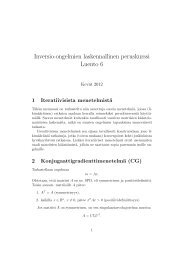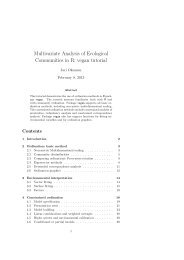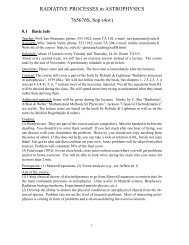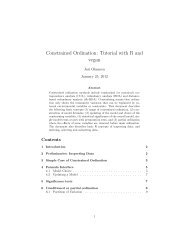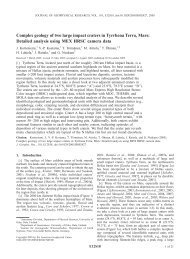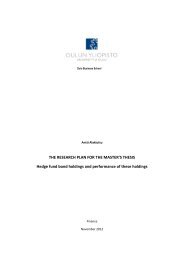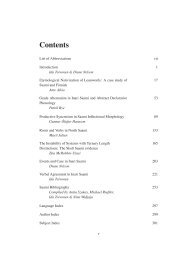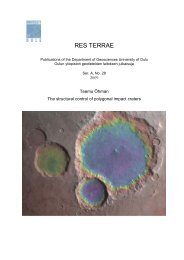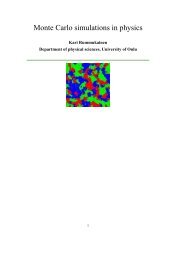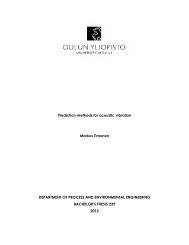Juha Köykkä - Oulu
Juha Köykkä - Oulu
Juha Köykkä - Oulu
- TAGS
- juha
- oulu
- cc.oulu.fi
Create successful ePaper yourself
Turn your PDF publications into a flip-book with our unique Google optimized e-Paper software.
Res Terrae, Ser. A 32, J. <strong>Köykkä</strong>, Sedimentology of the Mesoproterozoic Telemark basin-fills, South Norway: implications for<br />
sedimentation processes, depositional environments and tectonic evolution<br />
ing, crushing, heavy-liquid separation, hand-picking, and the Wilfley concentration<br />
table), and they were photographed using an electron-microscope to identify suitable<br />
microanalytical locations. The U-Pb dating and isotope analyses were performed using<br />
a Nu Plasma HR multicollector ICPMS and a New Wave / Merchantek LUV-213 laser<br />
microprobe at the University of Oslo, Department of Geosciences. LA-ICP-MS in-<br />
volves the ejection of matter from a solid by a laser beam, ionization of the ablated<br />
material by argon plasma and the measurement of isotopic ratios by a mass spectrome-<br />
ter. The main components of the system include the following: (i) a vacuum system;<br />
(ii) a source (ICP) from which ions created by the sample are focused and accelerated;<br />
(iii) an analyzer in which ions are separated by their mass to charge ratios; and (iv) a<br />
detector, which converts the ion beam to a number.<br />
U-Pb geochronology is based on the natural decay of 238 U and 235 U to stable 206 Pb<br />
and 207 Pb with half-lives of 4.468 Ga and 0.704 Ga. In this thesis, masses 204, 206,<br />
207, and 238 were measured, and 235 U was calculated from 238 U by using a natural<br />
238 U to 235 U ratio of 137.88. Mass 204 was used as a monitor for common 204 Pb. The<br />
raw data were reduced to U and 206 Pb concentrations and U-Pb isotope ratios by a<br />
sample-standard bracketing routine similar to that used by Jackson et al. (2004). The<br />
zircon used for calibration included zircon standards GJ-01 (609 ± 1Ma; Jackson et al.,<br />
2004) and 91500 (1065 ±1 Ma; Wiedenbeck et al., 1995) and an in-house Paleoprote-<br />
rozoic standard A382 (1876 ±2 Ma; Patchett and Kouvo, 1986). The program Isoplot<br />
Ex 3.0 (Ludwig, 2003) was used to plot the concordia and probability density dia-<br />
grams. Zircon standard 91500 was also run as an unknown to verify the accuracy of<br />
the method. The concordia age calculated from all of the standards run as unknowns<br />
was 1054 ±3 Ma, which is slightly younger than the reported TIMS age. The laser set-<br />
tings were ca. 32 % power, 40-µm spotsize and 10-Hz repetition rate. The data are pre-<br />
sented in the 207 Pb/ 235 U vs. 206 Pb/ 238 U diagram, called the concordia diagram, in which<br />
the ensemble of the points having the same age with the two isotope systems ( 238 U-<br />
206 Pb and 235 U- 207 Pb) defines the concordia line. The 207 Pb/ 206 Pb age can be visualized<br />
as the projection of the analytical point on the concordia line from the origin of the di-<br />
agram (0, 0). An example of the concordia diagram is given in Figure 7.<br />
176 Lu decays to 176 Hf with a half-life of ca. 3.73 ±0.05 to 3.69 ± 0.02 × 10 10 yr. In<br />
this thesis, masses 172-179 were measured for the Lu-Hf isotope analysis of zircon.<br />
46



